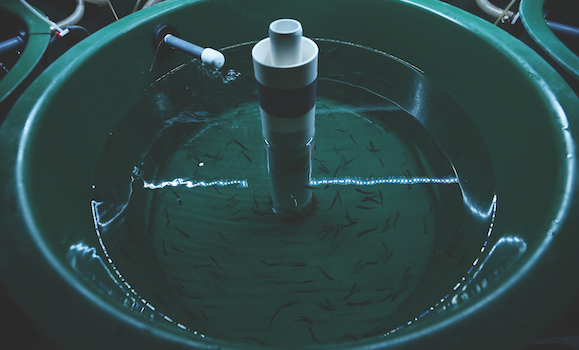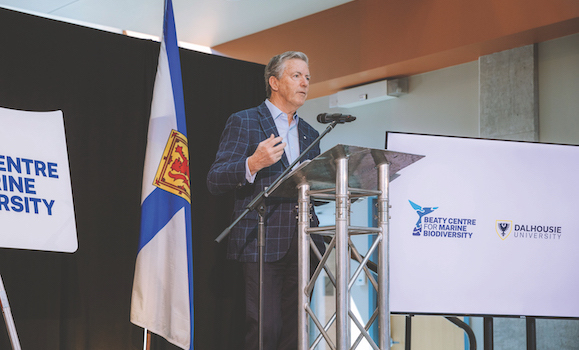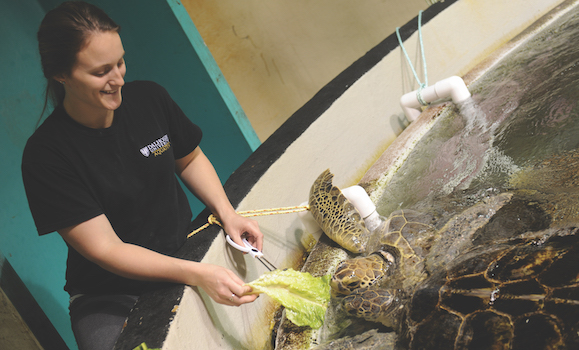Dalhousie professor Dr. Paul Bentzen is in a race against time. Supported by a team of researchers and students, he’s breeding and studying the Atlantic Whitefish with the goal of bringing it back from the brink of extinction.
But he’s not doing this in the Petite Rivière watershed—the only place in the world where they live in the wild. He’s doing it at the Aquatron Laboratory in the Life Sciences Centre.
“We can’t study them in the wild because there are not enough left, and that would be too invasive given their endangered status,” Dr. Bentzen explains. “The Aquatron creates an opportunity for us to better understand their biological needs and look at solutions such as expanding their habitat.”
Built in 1974, the Aquatron is a marine and freshwater research facility that is the largest of its kind among any university in Canada and among the best in the world. Its renown rests in part on its six large, specialized seawater tanks, which range in capacity from one litre to nearly 800,000 litres of water—all able to mimic an open- sea environment. And it has a dedicated support team that assists Dalhousie researchers with everything from setting up their experiments to feeding the marine life being studied.
Related reading:ĚýBehind the science: A glimpse into Dalhousie's Aquatron (Dal News, 2018)
“It’s like a marine research ship turned inside out because we have the water inside,” explains John Batt, the Aquatron’s manager. “And like a ship, we couldn’t keep it running without a great team. Their expertise, combined with our cutting-edge equipment, enable us to engage in research activities that few other centres can do.”

Some inhabitants of the Aquatron (Danny Abriel photo).
It’s no wonder that the Aquatron has attracted interest from people like former German Chancellor Angela Merkel and Prince Albert II of Monaco, who have both toured the facility. The Aquatron has also attracted research grants, gifts, and partnerships that are not only strengthening Dalhousie’s reputation as a world-leading hub of ocean research, but also creating new opportunities to conserve marine life and improve the health of the planet.
One such opportunity is . This ambitious Dalhousie-led project will use the Aquatron to explore ocean alkalinity enhancement (OAE) as a possible solution to global warming. In May 2023, the project received a $15 million gift from Carbon to Sea, a non-profit philanthropic program that supports OAE research.
“Scientists agree that OAE has enormous potential to permanently remove and store carbon, and our mission is to empower scientists to determine whether it can succeed at the scale we need,” says Mike Schroepfer, board chair of the Carbon to Sea Initiative and former chief technology officer at Meta Platforms, which owns Facebook. “Given Dalhousie’s expertise in the space and its deep global network in ocean science, it became a natural partner for the project.”
Related reading:ĚýDal’s Aquatron makes a splash in Parks Canada salmon replenishment project (Dal News, 2021)
The Aquatron will also be a driving force for the newly announced Beaty Centre for Marine Biodiversity. Scheduled to be completed in early 2025, this first-of-its-kind, interactive, ocean-focused science and discovery centre will be accessible to both the entire Dalhousie community and to the public. It will feature several exhibits that will demonstrate the outcomes of research in the Aquatron involving species under threat and will highlight the university’s efforts to conserve them.
The centre has been made possible thanks to an $8.2 million gift from entrepreneur and conservationist Ross Beaty and his family. “Education and awareness about marine biodiversity are crucial to support informed action to protect it, particularly in light of today’s twin crises of global warming and species extinction,” says Beaty. “I am pleased to support Dalhousie University’s efforts to share its extensive expertise in marine science through the creation of this centre.”
Read more:ĚýMajor gift propels creation of new ocean science centre that will draw community to campusĚý(Dal News)

Ross Beaty talks about the Centre for Marine Biodiversity (Cody Turner photo).
As the Aquatron team prepares for these exciting undertakings, it is also looking to deepen collaborations with valued partners like Ripley’s Aquarium of Canada in Toronto, which celebrated its 10th anniversary in October 2023. The Aquatron hosted two adult green sea turtles while the aquarium was being built, and helped to develop an Atlantic fisheries exhibit at Ripley’s Aquarium of Canada featuring cod and halibut.
“It’s been a fantastic relationship from the start between us, Dalhousie, and the Aquatron lab,” says Peter Doyle, general manager of Ripley’s Aquarium of Canada. “The facility is great, but it’s the team that they have put together that really makes it a pleasure to work with them. We are discussing how we can continue to collaborate going forward.”
Those discussions include the creationof an Atlantic Whitefish exhibit at Ripley’s Aquarium of Canada to share the species’ plight with millions of Canadians. It’s just one way that Batt envisions the Aquatron continuing to have an impact on ocean health and marine life conservation for years to come. “The world is changing, which means more research for us to do,” he says. “We’re ready, even as we adapt to meet the emerging challenges facing the planet.”

Snack time for sea turtles (Bruce Bottomley photo).
This story appeared in theĚýDAL Magazine Fall/Winter 2023Ěýissue. Flip through the rest of the issue using the links below.


